
HMS Goliath was a pre-dreadnought battleship of the British Royal Navy and a member of the Canopus class. Intended for service in Asia, Goliath and her sister ships were smaller and faster than the preceding Majestic-class battleships, but retained the same battery of four 12-inch (305 mm) guns. She also carried thinner armour, but incorporated new Krupp steel, which was more effective than the Harvey armour used in the Majestics. Goliath was laid down in January 1897, launched in March 1898, and commissioned into the fleet in March 1900.

HMAS Pioneer was a Pelorus-class protected cruiser built for the Royal Navy at the end of the 19th century. She was transferred to the fledgling Royal Australian Navy (RAN) in 1912. During World War I, the cruiser captured two German merchant ships, and was involved in the East African Campaign, including the blockade of the cruiser SMS Königsberg and a bombardment of Dar-es-Salaam. She returned to Australia in late 1916 and was decommissioned. Pioneer was used as an accommodation ship for the following six years, then was stripped down and sold off by 1926. The cruiser was scuttled outside Sydney Heads in 1931.
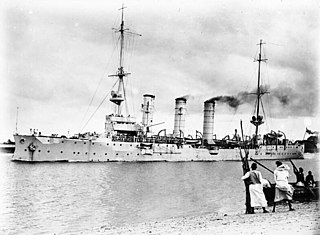
SMS Königsberg was the lead ship of her class of light cruisers built by the German Kaiserliche Marine. Named after Königsberg, the capital of East Prussia, she was laid down in January 1905, launched in December of that year and completed by June 1906. Her class included three other ships: Stettin, Stuttgart, and Nürnberg. Königsberg was armed with a main battery of ten 10.5-centimeter (4.1 in) guns and had a top speed of 24.1 knots.
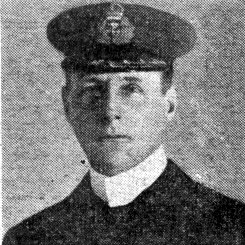
Henry Peel Ritchie VC was a recipient of the Victoria Cross, the highest and most prestigious award for valour "in the face of the enemy" that can be given to members of the British and Commonwealth armed forces. Ritchie received the first VC awarded to naval personnel during the First World War for his actions during a raid on the German colonial harbour of Dar-es-Salaam in November 1914, which left him seriously wounded.

HMS Fox was a second class protected cruiser of the Astraea class of the Royal Navy. The class represented an improvement on previous types, 1,000 tons displacement larger with better seaworthiness due to improved hull design. It also had somewhat increased firepower and superior arrangement of guns.

The Battle of the Rufiji Delta was fought in German East Africa from October 1914–July 1915 during the First World War, between the German Navy's light cruiser SMS Königsberg, and a powerful group of British warships. The battle was a series of attempts, ultimately successful, to sink the blockaded German light cruiser.

SMS Seeadler was an unprotected cruiser of the Bussard class, the third member of a class of six ships built by the German Kaiserliche Marine. Her sister ships included Bussard, the lead ship, along with Falke, Condor, Cormoran, and Geier. Seeadler was built at the Kaiserliche Werft in Danzig in late 1890, launched in February 1892, and commissioned in August of that year. Intended for colonial service, Seeadler was armed with a main battery of eight 10.5-centimeter (4.1 in) guns and had a top speed of 15.5 knots.

HMS Hyacinth was one of three Highflyer-class protected cruisers built for the Royal Navy in the 1890s. Initially assigned to the Channel Fleet, she spent much of her early career as flagship for the East Indies Station. She was reduced to reserve in 1912 after a lengthy refit before becoming the flagship of the Cape of Good Hope Station in 1913. After the beginning of World War I in August 1914, she spent the first few months of the war escorting convoys around South Africa. In early 1915, she was deployed to German East Africa to blockade the German light cruiser SMS Königsberg. She destroyed a German blockade runner attempting to bring supplies through the blockade in April and sank a German merchant vessel in early 1916. Hyacinth remained on the Cape Station for the rest of the war and was paid off in 1919, although she was not sold for scrap until 1923.
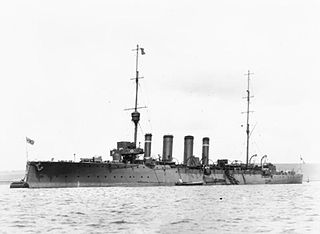
HMS Dartmouth was a Town-class light cruiser built for the Royal Navy in the 1910s. She was one of the Weymouth sub-class of the Town class. The ship survived the First World War and was sold for scrap in 1930.
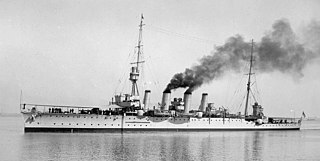
HMS Chatham was a Town-class light cruiser built for the Royal Navy in the 1910s. She was the name ship of her sub-class of the Town class. The ship survived the First World War and was sold for scrap in 1926.
Manza Bay is a bay in Mkinga District of Tanga Region of Tanzania. The bay is home to Kwale Island and is surrounded in the north by Boma peninsula. It is on the coast, some 10 miles (16 km) north of the town of Tanga.
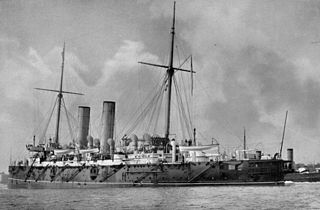
The Commander-in-Chief, Africa was the last title of a Royal Navy's formation commander located in South Africa from 1795 to 1939. Under varying titles, it was one of the longest-lived formations of the Royal Navy. It was also often known as the Cape of Good Hope Station.

The QF 4-inch gun Mks I, II, III were early British QF (quick-firing) naval guns originating in 1895. They all had barrels of 40 calibres length.

HMS Astraea was an Astraea-class second class cruiser of the Royal Navy. She was built towards the end of the nineteenth century, and survived to serve in the First World War.

The Astraea class was an eight ship class of protected cruisers built for the Royal Navy during the 1890s. The ships served on a number of foreign stations during their careers, particularly in the waters of the Indian and Pacific Oceans, and around the Cape of Good Hope. Already obsolete by the outbreak of the First World War, most continued to see service in a variety of roles, though rarely in a front line capacity. By the end of the war the majority were being used as training or depot ships, and they were soon sold out of the service and scrapped. However, one ship, HMS Hermione, was bought by the Marine Society and used as a training ship until 1940.
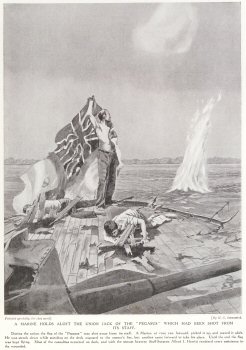
The Battle of Zanzibar was an encounter between the German Kaiserliche Marine and the British Royal Navy early in the First World War. While taking on coal in the delta of the Rufiji River in German East Africa, the German cruiser SMS Königsberg learned that a British cruiser, HMS Pegasus, which had been part of the Royal Navy's Cape Squadron sent to counter Königsberg, had put in at Zanzibar for repairs. Königsberg's captain, Commander Max Looff, decided to attack Pegasus while she was in port.
HMS Helmuth was a German tug that the Royal Navy captured at the beginning of World War I and armed as a picket boat. She served in the East African campaign including the battles of Zanzibar and Tanga, she survived a German attack at Dar es Salaam, and took part in blockading SMS Königsberg in the Rujifi Delta. In 1916 she took part in an amphibious assault on the coastal town of Bagamoyo.
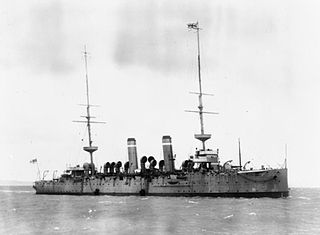
HMS Eclipse was an Eclipse-class protected cruiser built for the Royal Navy in the mid-1890s.

During the First World War, the Commander-in-Chief at the Cape, Rear Admiral Herbert King-Hall, expended much effort to destroy the elusive German light cruiser Königsberg.
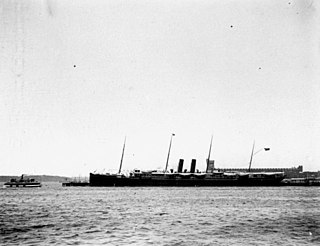
SS Himalaya was a P&O steam ocean liner that was built in Scotland in 1892 and scrapped in Germany in 1922. She operated scheduled services between England and Australia until 1908, and then to and from Japan until 1914.





















